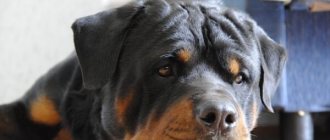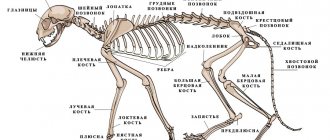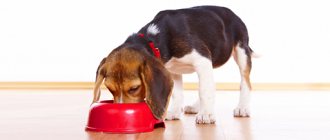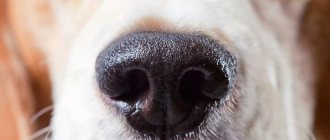The body of almost all dog breeds is covered with hair.
Wool is a kind of barrier between the dog's body and the environment. It can be compared to a thermos: in winter it helps to retain heat, in summer it protects against overheating. But, unfortunately, if the heat is too long, the heat remains in the body and it becomes very difficult to get rid of it due to the fur that prevents cooling. A natural way of thermoregulation is sweating. During this process the body cools down. But the question is: do dogs sweat? Yes, they sweat, but it happens differently for them than for people.
General information
There are two types of sweat glands in a dog's body:
- The first type helps cool the body, the second type does not.
- The second type is the main one in dogs and is called apocrine.
Any hair on a dog's body contains an apocrine gland. This sweat gland has another property - it releases hormones through which dogs transmit information to each other. But these sweat glands do not help remove moisture through the skin, which could help reduce a dog's body temperature. The sweat coming out through the apocrine glands is of an oily consistency. It has no smell. But when it encounters skin bacteria, it develops an odor.
The first type of sweat glands is called merocrine. In dogs, this type of gland is located on hair-free skin, namely on the pads of the feet and on the nose. The sweat produced by these glands consists of water and sodium chloride. Areas of the skin that are free of hair have the ability to remove moisture through the eccrine glands. This can only happen when the body heats up.
Prevention of blockage of the paraanal glands
To avoid problems and prevent the negative consequences of inflammatory processes, it is worth providing your pet with high-quality prevention. To do this, you need to follow these recommendations:
Walk your pet often. The less often the dog empties its intestines, the worse the secretion is removed from the glands. Walking is quite active. An insufficiently active lifestyle causes constipation in your pet and provokes inflammatory damage to the glands. Monitor your dog's diet
It is important to ensure that the stool is properly formed. This will help prevent constipation and diarrhea.
Abnormal bowel movements increase the likelihood of blockage and inflammatory damage to the paraanal glands. Excessive amounts of protein and carbohydrates in the diet often cause constipation. A dog's diet must contain a sufficient amount of fiber. It helps normalize digestive functions. Carry out hygienic procedures systematically. In this case, it is worth assessing the condition of the glands. Young animals are recommended to perform a similar check annually. For older pets this is done more often - every 6 months.
Diet
A balanced diet is a key factor in the prevention of inflammation of the paraanal glands
If your pet has a tendency to blockage of the anal glands, then it is important to ensure the normal functioning of the digestive system
If your dog eats exclusively industrial food, then you should choose from those types that are recommended for dogs with digestive problems. The serving size and number of doses are calculated by the veterinarian, taking into account the individual characteristics of the pet.
Often, the veterinarian prescribes a vitamin and mineral complex to strengthen the pet’s immunity.
Diet and an active lifestyle are the best prevention of blockage of the paraanal glands
Sonation of the paraanal glands
Pet hygiene is the responsibility of the owners. Cleaning your teeth and ears should not be difficult after some preliminary training and practice. But the issue of hygiene of the paraanal glands becomes a difficult task for some owners, and absolutely impossible for those who are particularly squeamish. If you wish, the veterinarians of the Veterinary House clinic will explain to you how to properly clean the glands in dogs, and if you do not want to perform the manipulation yourself, they will determine the interval for filling the bags and draw up the best schedule for visits to the clinic.
The anal sacs (glands) are located on the sides and slightly below the anus. These bags are gradually filled with a special secretion, with the help of which the animal marks its territory. It has an individual unpleasant odor and is a kind of personal marker of a particular individual. During each bowel movement, fecal pressure is exerted on the glands, causing fluid to be removed from the body. In other words, cleaning the glands in cats and dogs is often done independently; owners may not even know about the existence of such a problem.
When secretions accumulate inside the glands for a long time, pets begin to experience discomfort near the anus area. Following their instincts and trying to get rid of unpleasant sensations and squeeze out the liquid, dogs begin to crawl on the floor, rub against carpets or other surfaces with pile. If relief does not come, the animal begins to gnaw the area at the base of the tail, shows more and more anxiety, sometimes suddenly jumps up and tries to wriggle towards its croup, as if catching someone invisible. Feel the area under the tail using gloves for hygiene purposes. When you feel tight areas with gentle pressure, this means that the sacs are definitely full and cleaning of the anal glands in dogs should be done soon.
How to avoid blocked anal glands in a dog?
There is a list of recommendations that if you follow, you will never know that dogs are suffering from a similar illness.
- Try to arrange walks for the animal as often as possible, as this will avoid the dog having to endure waiting for the opportunity to relieve itself.
- give the animal the necessary physical activity, since a sedentary lifestyle can cause malfunctions in the dog’s body;
- pay close attention to your diet. The dog should eat a balanced and regular diet;
- During a routine veterinary examination, ask your doctor to examine your dog's anal glands, especially if you have observed any of the above symptoms.
Thermoregulation of dogs
Any living organism controls its body temperature with the help of the brain. There are cold-blooded and warm-blooded animals. Dogs are warm-blooded animals, just like cats, which maintain the desired body temperature. In fact, dogs do not sweat like humans, although they do have glands on their bodies that resemble sweat glands.
They are located on the muzzle, namely on the nose, and on the paws between the toes and on the pads of the toes. The liquid released from the glands on the paws dries quickly and refreshes. She has no smell. The secretion coming out of the glands on the muzzle has a thicker consistency and smell. This is what gives rise to the smell of wet dog.
REFERENCE! You can understand that a dog is sweating only by seeing wet marks from its paws.
Dogs know how to cool down differently. To do this, they stick out their tongue and breathe quickly through their mouth. When they are hot, the dog's body temperature increases. In addition to the temperature, salivation begins to increase. You may also notice your nose and eyes are wetter than usual. Saliva tends to evaporate quickly due to its salt content, which cools the dog's mouth.
REFERENCE! When a dog breathes through his mouth with his tongue hanging out, his nose and ears become cold. This is explained by an increase in capillaries and rapid cooling of surfaces. Due to the faster heart rate, blood passes through the vessels faster and cools.
Due to increased salivation, the body spends salts and electrolytes, and this in turn inhibits the breakdown of carbohydrates, which are the main source of heat. And since they are not absorbed, the dog’s body cools down faster.
Heat transfer mechanism
Sweating in dogs whose body is covered with thick hair does not occur by releasing sweat through the pores. The organs of the respiratory system are involved in the main process of heat transfer. Some of the sweat comes out of the body through contact.
Polypnoetic
In the heat, the dog begins to breathe through its mouth. The animal's oral cavity contains a large number of blood vessels. During breathing, moisture evaporates, causing heat to escape from the veins and capillaries.
But the hotter the inhaled air, the more difficult it is for the dog to cool down using this method. The nasal gland helps cool the air; humans do not have it. This gland helps keep the nasal mucosa cool and moist.
Additional Information! In a calm state, the dog’s breathing rate per minute ranges from 30 to 40 times. At high ambient temperatures, the frequency increases up to 100-300 times.
Contact or hemological
Contact exchange is a process in which hot blood and cold air collide. This heat transfer mechanism occurs in those places of the body where thermal protection is minimal - the genital area, ears, and abdomen. The higher the temperature, the more the blood vessels in these parts of the body dilate. Due to the expansion of blood flow, heat transfer increases.
Overheating dogs
Thermoregulation is a natural process, so it always works if the dog is absolutely healthy. If a dog is sick, it cannot cope with the increase in body temperature on its own and may overheat and even die.
Overheating can cause:
- - the dog has a fever in response to an infection or virus;
- — the dog has experienced severe stress or excitement;
- — increased air temperature;
- - keeping the dog near heating devices or a fire;
- - keeping the dog in the car in the heat;
- - hard, exhausting workouts in the warm season;
- - lack of water, as a result - dehydration;
- - inability to hide from direct sunlight.
IMPORTANT! The standard temperature for dogs is 38-39 degrees.
You can talk about a dog overheating only after measuring its temperature. If the temperature is still higher than standard, the dog must be left alone in a cool room for 15-20 minutes. If your dog experiences vomiting, excessive salivation, pupils of different sizes, dizziness and other uncharacteristic conditions, you need to quickly provide the necessary first aid and get to the veterinarian as soon as possible.
Causes of skin diseases
Animal skin diseases in veterinary medicine (dermatitis) are one of the most common pathologies. This is due to the fact that problems with the animal’s fur and skin are easy to notice with the naked eye.
The reason may be various factors:
- poor nutrition;
- stress;
- adverse reactions to medications;
- allergies to food, chemicals;
- a bowl made of low-quality, toxic plastic;
- worms, fleas, ticks;
- contact with a sick animal;
- fungi;
- skin trauma, especially wounds accompanied by inflammation;
- chronic diseases of internal organs.
Other cooling methods
Dogs don't sweat as much as people. This happens due to the fact that more often the dog’s body cools itself with the help of its tongue. If a dog gets hot, it will stick out its tongue and pant rapidly. In hot weather, dogs make about 400 respiratory cycles, in normal weather - only about 40 cycles. Air is inhaled through the nose and moisture comes out of it, after which warm air comes out through the mouth.
As a result, the nose becomes cold. In addition, due to the fact that saliva evaporates, the tongue also cools. Then the blood that passes through the tongue also cools.
The spleen controls the dog's body temperature. It is quite large and due to this, a decent amount of blood can be stored in it, which, if necessary (when the body heats up), can be released. At the base of a dog's neck there are many small veins and arteries that separate the head from the body. Therefore, the brain, which is very sensitive to high temperatures, is protected from extreme heat. For these reasons, dogs are more resilient than humans and many other animals.
Do Sphynx cats sweat?
This cat breed is an exception to the rule.
The lack of hair in sphinxes gives rise to their own characteristics of the body. These cats sweat all over their bodies, this is especially noticeable in completely naked individuals. Some Sphynx owners notice that their pets may leave a mark on the surface on which they like to spend time. These cats require special care; they need periodic baths or wiping their bodies with wet wipes.
How much a Sphynx sweats depends on the individual characteristics of the body and state of health. Some representatives of this breed sweat a little. But it also happens that the sphinx’s profuse sweating is a real problem for the owners, since brown sweat stains on furniture and other surfaces create a certain discomfort.
Thus, to the question “Do Sphynx cats produce sweat?” the answer will be yes. If there is too much sweat, you need to contact a veterinarian, your pet may have health problems.











